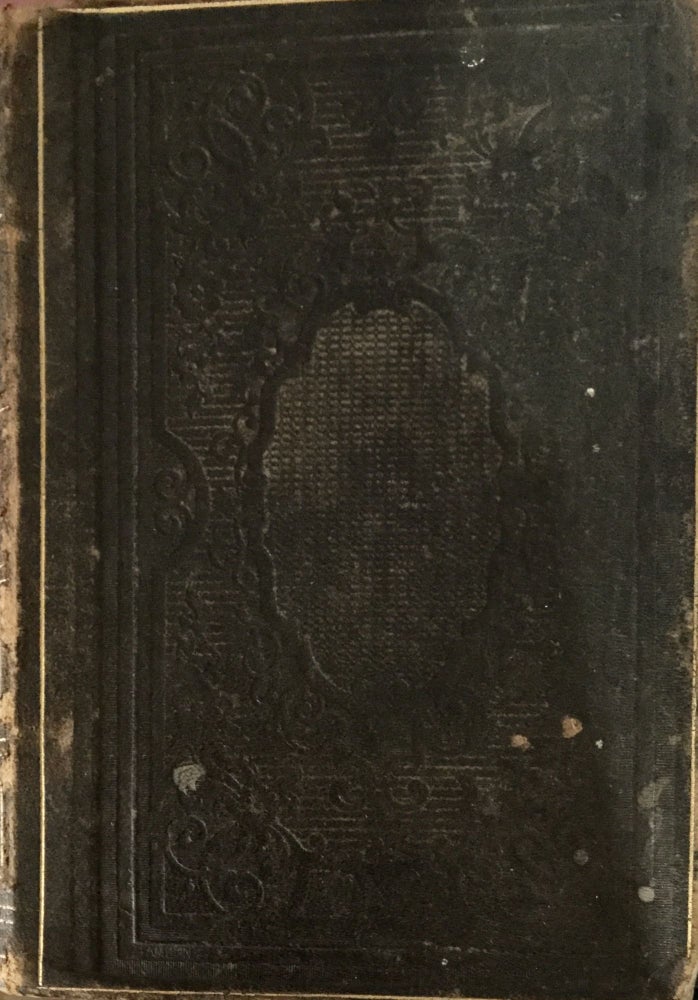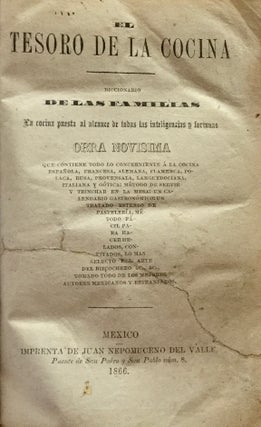EL TESORO DE LA COCINA DICCIONARIO DE LAS FAMILIAS. LA COCINA PUESTA AL ALCANCE DE TODAS LAS INTELIGENTES Y FORTUNAS OBRA NOVISIMA QUE CONTIENE TODO LO CONCERNIENTE Á LA COCINA ESPAÑOLA, FRANCESA, ALEMANA, FLAMENCA, POLACA, RUSA, PROVENSALA, LANGUEDOCIANA, ITALIANA Y GÓTICA; MÉTODO DE SERVIR Y TRINCHAR EN LA MESA: UN CALENDARIO GASTRONÓMICO: UN TRATADO ESTENSO DE PASTELERÍA, MÉTODO FÁCIL PARA HACER HELADOS, CONFITADOS, LO MAS SELECTO DEL ARTE DE BIZCOCHERO, &C., &C., TOMADO TODO DE LOS MEJORES AUTORES MEXICANOS Y ESTRANJEROS.
México, D.F: Imprenta de Juan Nepomuceno del Valle, Puente de San Pedro y San Pablo núm. 8, 1866. contemporary brown embossed Mexican sheep, spine gilt lettered and decorated. (spine gilt lettered and decorated; spine and boards rubbed, corners bumped; title page with crudely repaired tear; pp 469-474 with small tear in upper margin not affecting text; o/w clean except for a few minor food stains, tight). Item #92806
First edition. Not in standard sources, but mentioned in Janet Long, Conquista y Comida: Consequencias del encuentro de dos mundos (Mexico: UNAM, 2003, p. 473). This anonymously written dictionary-cookbook is divided into four sections: recipes; setting the table (illustrated by some of the lithographs); a gastronomical calendar indicating which vegetables and spices are in season; and the art of carving at the table (also illustrated by some of the lithographs). As the title indicates, many of the recipes are of foreign origin (e.g. “Peras á la alemana” and “Peras de Inglaterra confitadas”), although many of the ones given are native Mexican dishes using traditional ingredients. In some instances, the recipes for particular animals are extensive. For example, one finds eighteen different recipes, including a large sample of foreign dishes, for partridges. Drink and cake recipes are also extensive, including some borrowed from foreign cultures. Included, for example, is “Ponche inglés,” about which it is observed: “Esta bebida inglesa se ha propagado ya demasiado entre nosotros. Se la reputa capaz de restaurar las fuerzas del individuo, y se mira como un escelente dijestivo, pero su abuso es peligroso” (p. 388). (The modern reader will recognize this drink as rum punch, here made with lemonade.) That recipe is supplemented by several more for native pulque and for a concoction called “Punche de muertos” (p. 395). Getting the food prepared is only half the battle, however, since it must eventually be served. The two sections on dining are replete with social customs and fashions, some of which were apparently problematic, especially for large gatherings. The first piece of advice, for example, is to clean thoroughly and be prepared well ahead of time so that problems can be corrected. The author may well have suffered a few unpleasant meals, for warnings are given against trying to seat people too close together and against using the wrong kind of lighting. (The author prefers those suspended from the ceiling rather than those that sit on the table, which cast shadows and can be knocked over.) The author also apparently underwent rude servants at some point, because their appearance and behavior are specifically commented upon. Finally, the author also seems to have witnessed problematical carving, because obvious pitfalls are warned against: the knives must be of various but correct sizes, must be sharp, and the carving preferably takes place at a side table by someone with the proper knowledge and skills (“Sus manos deben ser ájiles y bien aseguradas, sus brazos flexibles y rollizos…”). All the plates serve to illustrate various table settings and the carving process for various cuts of meat (sides of beef, pork, various fowl, and fish). OCLC shows two copies (UCSD, UTSA).
Price: $2,500.00



